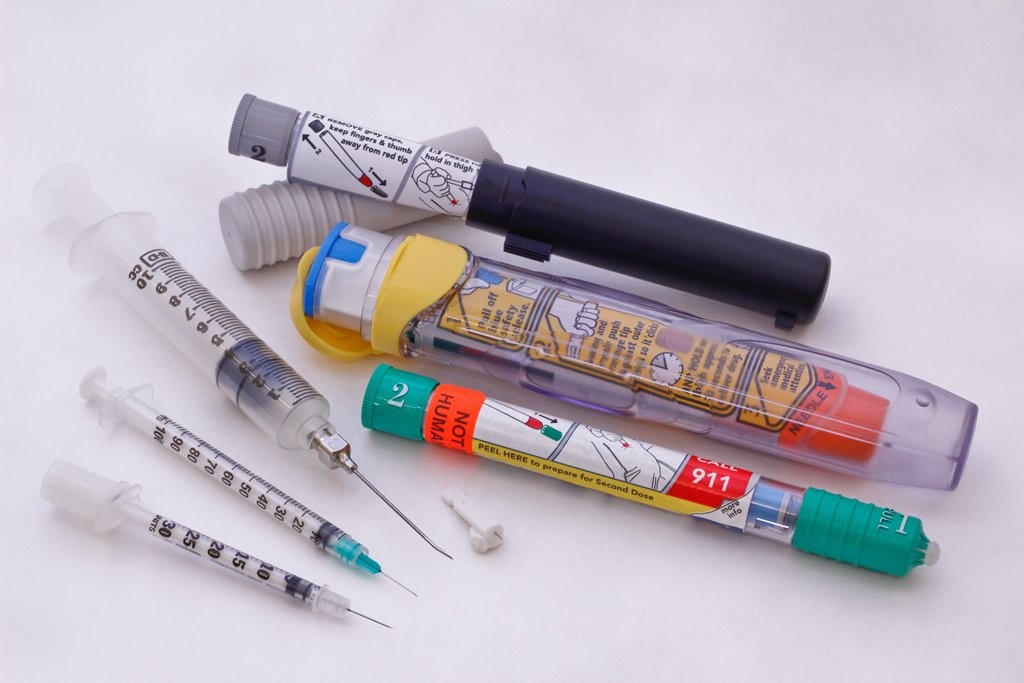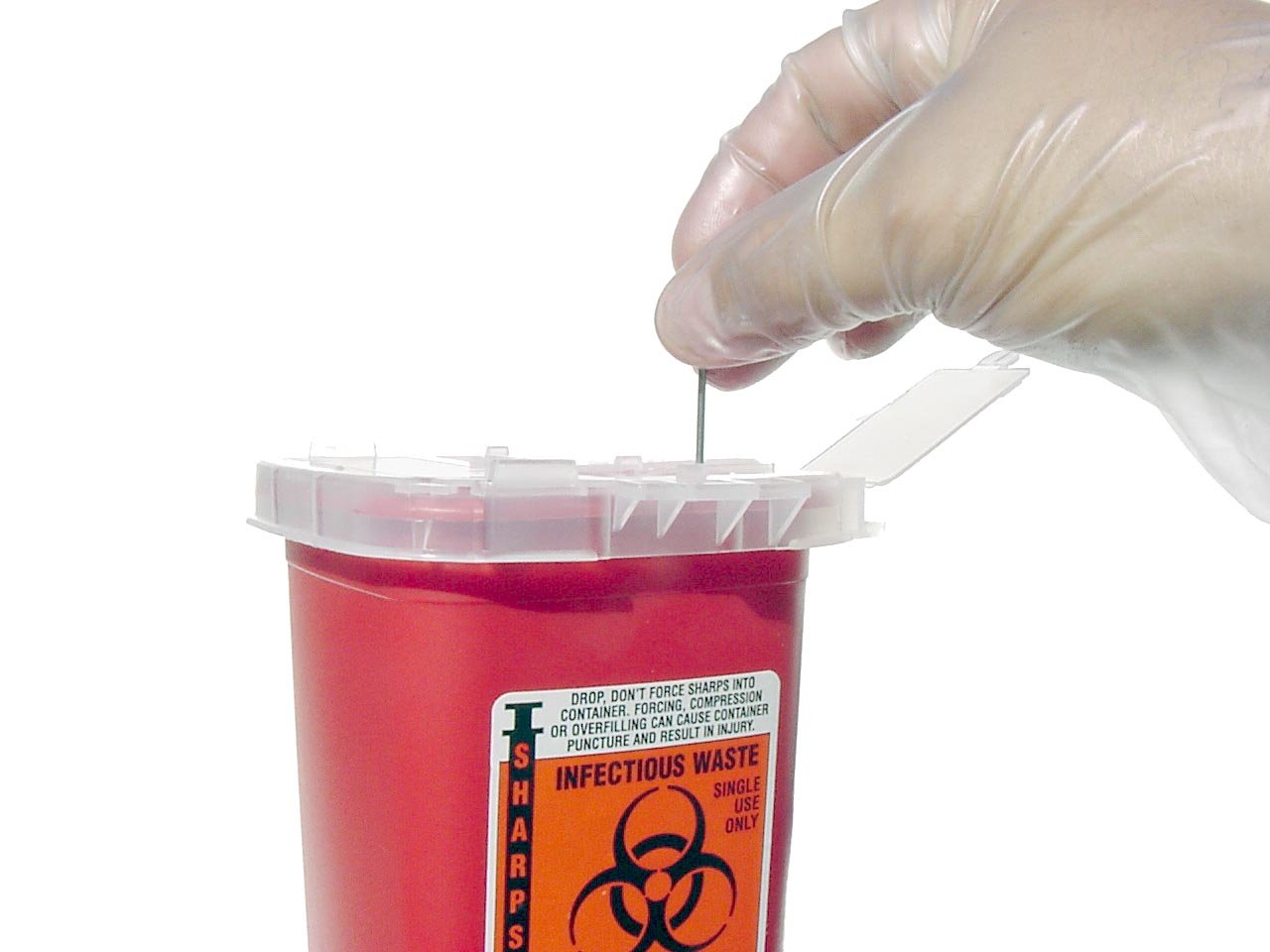Sharps disposal can be a tricky business. One needle stick can take a life, or deliver thousands in fines from the EPA or other government bodies. To make things worse, regulations are always in flux, and they can change drastically across state or even local lines.
The tendency is to “err on the side of caution.” Unfortunately, that can also send costs exploding through the roof.
Where’s the “sweet spot” for sharps disposal? In the waste disposal world, knowledge truly is power. Below, find answers to all your questions, from “What are sharps?” to sharps disposal best practices and more.
Sharps Disposal
Sharps can be defined as “any object that can cut or pierce the skin.” In the medical world, there’s an added element from potential contamination by bloodborne pathogens. Because this combination can spread disease, proper sharps disposal is a priority in any healthcare facility.
Here are some examples of sharps requiring special disposal in a sharps container:
- Needles. Hollow needles used for injecting medications.
- Syringes. The “plunger” body used to inject drugs. May have needle attached.
- Lancets. AKA “fingerstick” devices. These short, double-edged blades are used to get blood drops for testing. (Think, “diabetes blood test prick.”)
- Infusion Sets. Tubing/needle systems used to deliver medications beneath the skin.
- Epi Pens. Auto injectors pre-filled with epinephrine in case of anaphylactic shock.
- Insulin Pens. Auto-injectors pre-filled with insulin for diabetics.
- Connection Needles / Connection Sets. Needles that connect to tubes. Mainly used for home hemodialysis patients.
- Scalpels and other blades.
- Scissors used to cut flesh or dressings.
- Glass. Even unbroken glass that hasn’t necessarily been contaminated may still need sharps disposal.
- Sharp Plastic may need special disposal.
Sharps Disposal Methods
The FDA recommends putting all sharps in a special sharps disposal container. After that’s done, there are three main disposal methods.
- Mailback. This sharps disposal method literally sends the biohazardous waste through the mail. Since the sharps are properly packaged and labeled first, it’s safe and legal.
- Collection. One sharps disposal choice is packaging medical waste on-site. A disposal company then comes to collect it and take it off for treatment.
- On Site Treatment. Some facilities elect for on-site sharps disposal. This is the most resource-intensive method, since it requires specialized equipment.
Why Sharps Disposal Matters
Via: Wikipedia
According to the NIH, proper sharps disposal can stem the spread of infectious bloodborne pathogens.
Data suggests that 16% of all occupational injuries in hospitals come from sharps.
Sharps injuries vastly increase the risk to hospital workers of diseases like Hepatitis B, Hepatitis C, and HIV.
Proper sharps disposal eliminates or greatly reduces the risk of sticks and infection.
Improper sharps disposal carries hefty fines.
Containers for Sharps Disposal
What are the different containers for sharps disposal? How many are there? What are the colors?
MedPro’s red sharps disposal containers come in several handy sizes. Each leakproof, puncture-resistant container comes with a prepaid mailback shipping box, reducing waste disposal costs as much as 50%.
Sizes
- 1.2 Gallon Sharps Disposal System
- 2 Gallon Sharps Disposal System
- 3 Gallon Sharps Disposal System
- 5 Gallon Sharps Disposal System
- 8 Gallon Sharps Disposal System
- 18 Gallon Sharps Disposal System
- 28 Gallon Sharps Disposal System
Find Out How Much You Can Save Instantly.
Try our on-line savings calculator.
Sharps Disposal Best Practices
The NIH lists several principles for the safe disposal of sharps.
Healthcare staff should follow best practices for safe sharps handling and disposal. Important rules include handling sharps as little as possible, then immediately discarding them in a puncture-resistant, sealed container.
Sharps containers themselves are covered by several safe handling standards. Containers should be filled only to the “fill line,” closed between uses, and kept out of reach of the public.
Safe Handling:
- Sharps should not be passed from hand to hand.
- Used needles must not be broken or bent before disposal.
- Used sharps must immediately be discarded in a sharps container.
Sharps Containers:
- Must be located to avoid spillage.
- Must be kept at a height that allows safe sharps disposal.
- Must be kept away from public access.
- Must not be overfilled.
- Must be disposed of once full.
- Should be closed between uses.
- Must not be used for purposes other than sharps disposal.
- Should be disposed of after 3 months even when not full.
Sharps Disposal Near You
Looking for local sharps disposal? MedPro Disposal offers cost-effective, reliable medical waste disposal, including sharps disposal. In 44 states, small and large medical waste generators alike are never far from convenient disposal of sharps and other biohazard waste. With more than 80 regional affiliate haulers, quick, reliable, cost-effective disposal is always right nearby.
Sharps Disposal Blog Articles
MedPro has several informative blog posts about sharps.
Looking for sharps containers? Wondering what you can put in sharps containers, and what you can’t? Trying to figure out what to do with sharps from your home? MedPro’s blog is a wealth of disposal information.
Here’s a sampling of titles:
- Where Do I Get Sharps Containers?
- When Should I Dispose of my Sharps Containers?
- What Should I do with Used Needles?
- How Do You Dispose of Sharps Containers from Home?
- 5 Things to Consider Before Purchasing Sharps Containers
- What Can You Put in a Sharps Container?
For the full list of MedPro’s sharps articles, click here.
What to Ask Your Sharps Disposal Company
All sharps disposal companies are not created equal. Some carry different levels of insurance to protect their customers. Some hold their customers liable even while the waste is in transit. Certain companies levy much higher fees and charges for disposal. Some companies, meanwhile, offer waste disposal for as much as 50% less cost, with as much as $15 million in insurance to protect their clients.
The list below serves up a few questions to ask before you commit.
- Who’s liable for your medical waste? With some sharps disposal firms, you remain liable for your waste until it’s neutralized. With MedPro, you’re safe as soon as the waste leaves your facility.
- How much insurance do they carry? Does your firm have enough insurance to protect you in the event of a catastrophe? MedPro carries $15 million in insurance.
- How much experience does the company have? It’s as true in any business as it is in sharps disposal: experience matters. A smooth system of routes, processes, compliance, and affiliates doesn’t sprout up overnight.
- Are they transparent and accessible? There’s no one-size-fits-all solution to medical waste disposal. Your sharps needs may be light or heavy, and your area may have very different EPA regulations than those a few miles distant. Pick a partner who will talk to you and work with you.
- What are the fees? Find out what you’re paying, and what you’re paying for, up front. Waste companies can have very different fee schedules when it comes to sharps disposal.
- Will they train your staff? Proper disposal of sharps starts with your own staff. Sharps must be packaged and shipped according to regulations. Some companies provide this training.
- Are they compliant at every level? Sharps regulations vary by state, and even national disposal regulations can change. Choose a partner that’s always 100% compliant, up to date, and most of all, insured.
Sharps Violations
A harps violation can cost even a small practice $70,000 or more. Fines can come from OSHA, the EPA, or other national or local government bodies. Almost all sharps violations are avoidable. All it takes is a little knowledge.
Here are some of the most common sharps disposal violations.
- Disposing of sharps in non-compliant containers. Non-compliant containers include milk containers, water bottles, glass containers, or soda cans. All of these can puncture easily or break.
- Placing sharps in the regular trash. This practice exposes employees and members of the public to needle sticks. It also introduces biohazards into landfills.
- Bending or breaking needles before discarding. This is a habit thought by some to reduce the risk of needle sticks. In fact it’s been found to elevate the risk.
- Improperly sealing sharps containers. Sharps containers must be sealed to prevent spillage, and to prevent sharps being squeezed out under pressure.
- Incorrectly labeling containers. Sharps must be clearly labeled as biohazardous sharps in bright red, puncture proof containers.
- Putting sharps in the wrong container. Sharps should never be disposed of in recycling bins or other medical waste disposal containers.
What to Do if You Get a Needle Stick from a Sharp
A needle stick from a sharp can let a bloodborne pathogen in under your body’s defenses. That said, sticks don’t always mean infection. There’s a plan to fall back on if you’re injured by a sharp.
If you get a needle stick or a cut from a sharp, the CDC advises taking the following steps without delay:
- Wash the cut/needlestick with soap and water.
- Flush any splashes to your skin, mouth, or nose with water.
- Irrigate eye contamination with saline, sterile irrigants, or clean water.
- Report the needlestick or cut to a supervisor.
- Seek immediate medical treatment.
Conclusion
Sharps disposal is one of the most important duties of any healthcare worker. Proper disposal keeps us safe from bloodborne pathogens. Improper disposal opens us up to infection and hefty fines.
The key to staying safe from needle sticks and cuts is knowing what sharps are, and how to dispose of them. A reliable disposal company can carry the lion’s share of the sharps disposal burden.
A good partner can provide the sharps containers and systems that can keep your employees safe, and the training to ensure their proper use. A reliable waste disposal company like MedPro can do it all with $15 million in insurance, all at up to 50% less cost than other options.




